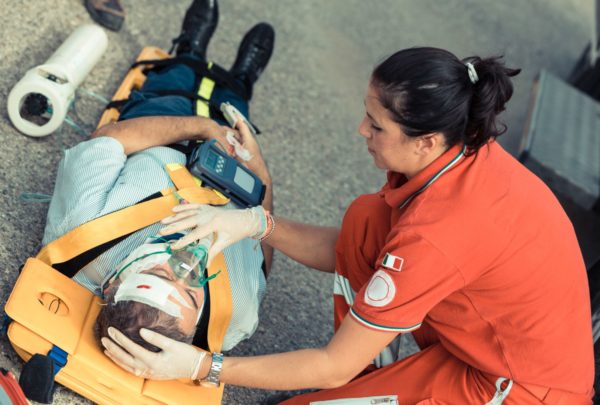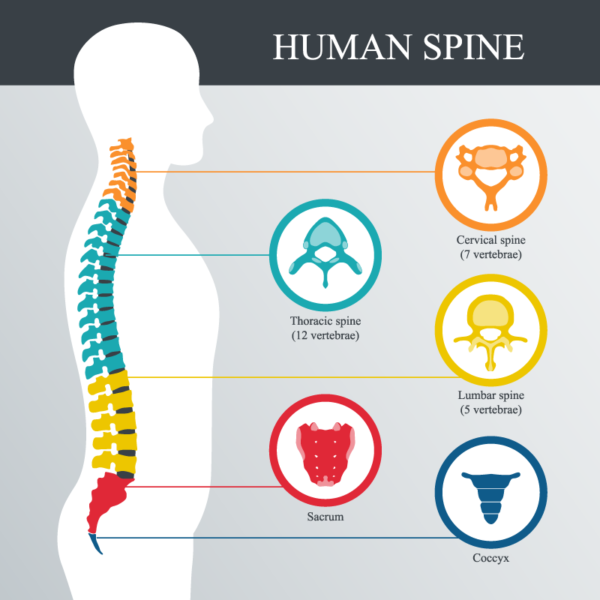Spinal Cord Injuries: Types, Treatment, and Compensation After an Accident

A spinal cord injury may be caused by damage to any part of the vertebrae, ligaments, discs, or nerves, often causing permanent changes to a person’s strength, sensitivity, and other bodily functions.
An injury to the spinal cord is more than just physical — it often affects a person mentally, emotionally, and socially.
Spinal Cord Anatomy
The spinal cord is part of the central nervous system. Made of soft tissue and protected by bones called vertebrae, the cord extends about 18 inches from the base of the brain and down the middle of the back.
Toward the end of the spinal cord is the region called the conus medullaris, which sits just above the waist. Below this area are the nerve roots cauda equina.
Tracts of nerve cells and lines extend from the spine out to different parts of the body like branches on a tree. The peripheral nerve tracts carry motor control directions to muscles and sensory signals that relate to heat, cold, pressure, pain, and limb position. Other nerve systems (sympathetic and parasympathetic) control involuntary functions such as blood pressure and temperature regulation.

How Spinal Cord Injuries Happen
Injuries to the spinal cord most often result from a traumatic blow that fractures, dislocates, crushes, or compresses one or more vertebrae in the spine. The most common causes of acute spinal cord injuries are car accidents and motorcycle accidents, particularly for males under the age of 65.
Traumatic spinal cord injuries can also be caused by acts of violence, such as gunshots and knife wounds. Alcohol is a common factor in 1 out of every 4 spinal cord injury cases.
Minor spinal cord damage can increase in severity over days and weeks due to bleeding, swelling, inflammation, and fluid build-up.
Types of Spinal Cord Injuries
Because the spinal cord interacts with every system below the brain, injuries and symptoms can vary widely. Spinal cord injury levels depend on where the injury to the spine is located and the severity of the injury. The higher up the spinal column a person is injured, the more dysfunction a person will generally experience.
Spinal Cord Injury Levels
The American Spinal Injury Association (ASIA) grades spinal cord injuries on a letter scale to describe severity:
- A. The injury is complete with no sensory or motor function remaining.
- B. Complete motor function loss with a sensory incomplete injury.
- C. An incomplete motor injury with some movement, but less than half the muscle groups can lift against the force of gravity in a full range of motion.
- D. An incomplete motor injury, with more than half the muscle groups able to lift against the force of gravity in a full range of motion.
- E. Normal motor and sensory function.
Complete vs Incomplete
The severity of a spinal cord injury is often understood in terms of “completeness.” A complete spinal cord injury means all feeling and motor control are lost below the injury site. An incomplete spinal cord injury indicates a person has some motor or sensory function below the injured area. There are varying degrees of incomplete spinal cord injury.
Nearly 50% of spinal cord injuries are complete, with both sides of the body equally affected. A severed spinal cord is rare — most complete spinal cord injuries cause a loss of function due to a contusion or lack of blood flow to the injured area. With an incomplete injury, a person may still have more motor and sensory function on one side of the body compared to the other.
Paralysis is a common symptom of spinal cord injuries. A person may suffer from tetraplegia (also known as quadriplegia), which can affect the hands, arms, torso, pelvis, and legs. Paraplegia affects some or all parts of the torso, pelvis, and legs.
Cervical Spine Injury
The neck is made up of seven vertebrae (C1-C7). An injury to the cervical spine can impact a person’s ability to move their arms, the ability to breathe, and other internal bodily functions since it is the gateway between the brain and the rest of the body. Cervical injuries usually result in quadriplegia. Any injuries above the C4 vertebrae may require a ventilator for a person to breathe.
Thoracic Spine Injury
The thoracic section of the spine runs from the shoulders to the middle of the back and features 12 vertebrae (T1-T12). The first thoracic vertebrae is where the top of your ribs attach. An injury to the thoracic region can result in paraplegia and affect your chest, legs, bowels, bladder, abdominal walls, and sexual organs.
Lumbar Spine Injury
The lumbar spine runs from the lower back to the pelvis. A spinal cord injury to the five lumbar vertebrae (L1-L5) will affect a person similar to a thoracic or sacral spinal injury.
Sacral Spine Injury
The sacral region (S1-S5) is located from the pelvis to the end of the spinal column. An injury here may result in the loss of some function in the hips and legs.
Spinal Concussions
Spinal concussions and contusions generally do not last very long. They are often indicated by neurological symptoms including numbness, tingling, electrical shocking sensations, and burning in the hands and feet.
Spinal Cord Injury Symptoms
A health care team will need to perform multiple tests to understand the neurological level and completeness of a spinal cord injury. Most spinal cord injuries involve one or more of the following symptoms:
- Changes in sexual function, sensitivity, or fertility
- Difficulty breathing or coughing
- Intense reflex responses or spasms
- Loss of bowel or bladder control
- Loss of movement
- Reduced sensation or loss (inability or problems feeling touch, heat, and cold)
- Pain or stinging sensations caused by damage to nerve fibers in the spine
Emergency symptoms, especially after a traumatic accident, may include:
- An oddly positioned or twisted neck or back
- Difficulty balancing and walking
- Difficulty breathing
- Loss of bladder or bowel control
- Numbness, tingling, or loss of sensation in your hands or feet
- Severe back pain or pressure in the head, neck, or back
- Weakness, uncoordinated movement, or paralysis in any part of the body
Can a Spinal Cord Injury Get Worse?
Yes. Any amount of trauma to the neck or spine requires immediate medical evaluation. It’s safer to assume a spinal injury exists until proven otherwise.
A serious spinal injury may not be immediately obvious in the aftermath of a car accident or other incident. The longer a spinal cord injury remains undiagnosed and untreated, the worse the injury will likely become.
Numbness and paralysis do not always happen right after the spinal injury occurs. Symptoms may appear gradually as the injury site on the spinal cord bleeds and swells.
The time between a spinal cord injury and treatment can be critical to determining the extent of the damage, treatment options, and potential recovery.
Can a Spinal Cord Injury Heal Naturally?
Without proper medical treatment and consistent physical therapy, a spinal cord injury can be fatal. A physical therapist can create a customized exercise plan to stimulate the brain, spine, and body to relearn how to work together. The best thing a person in recovery can do is to follow the advice of their doctor and attend all of their appointments.
Spinal Cord Injury Treatment
After an accident, a doctor will check to make sure a patient is breathing and has a pulse. Then they test for neurological functioning by evaluating the strength and sensitivity in the arms and legs. If there are obvious problems or the patient is not fully conscious, they are kept in a cervical collar and on a spine board until a scan can be done.
While X-rays can be used to image the spine, CT or CAT scans can also be used to identify fractures and other abnormalities. An MRI can look at the spinal cord itself and is useful for detecting blood clots, herniated discs, or other masses that may be present.
- Non-Surgical Treatments: A person with a spinal cord injury will most likely be placed in an ICU where they can be monitored while their spine is placed in proper alignment.
- Surgery: An operation may be immediately necessary if the spinal cord appears compressed by a herniated disc, blood clot, or lesion. In some cases, surgery may not be able to reverse the damage but is still needed to stabilize the spine to prevent future pain or deformity.
Recovery
It may be overwhelming dealing with the changes and complications present in your body after suffering an injury to the spine. A rehabilitation team can help you begin the recovery process and give you the tools you need to live an independent and fulfilling life.
Recovery depends on the severity of the spinal cord injury. Those who suffer a complete spinal cord injury are unlikely to regain sensitivity and motor control below the level of the injury. Any improvement usually happens within the first few days after the accident.
Improvement is more likely with incomplete injuries, but this can vary from person to person. A spinal cord injury is often caused by swelling along the spinal cord, altering nearly every system it is connected to. After a few days or weeks, swelling decreases and some functionality may be regained. In rare cases, some people who have suffered a spinal cord injury regain more function after 18 months or longer.
Supportive care and rehabilitation (physical therapy, occupational therapy, and counseling) will be necessary. These services can be provided at the hospital, a rehabilitation facility, or at home. An injured person may require a powered chair, a manual wheelchair, braces, crutches, or some varying combination.
Currently, there is no cure for spinal cord injuries. Advancements, however, are being made to decrease swelling and secondary damage post-injury and in the fields of computers and robotics.

Spinal Cord Injury Lawyer - Gary Martin Hays & Associates
Spinal cord injuries can significantly alter a person’s life in every way imaginable. Medical bills and other expenses quickly add up, leaving families trying to cope with unimaginable amounts of debt.
An injury to the spine can leave a person with life-long disabilities that impact their happiness, career, relationships, goals, and life expectancy. Financial stability is an absolute must in achieving a positive outcome after such a stressful and traumatic injury.
Our spinal cord injury attorneys help injured victims receive proper treatment and shield them from the insurance company and their lawyers. We understand the devastating impact a traumatic injury after a car accident or work accident can have on a person and their loved ones.
Know your rights and get just compensation for your injuries by contacting Gary Martin Hays & Associates today.
(770) 934-8000
Get Directions
